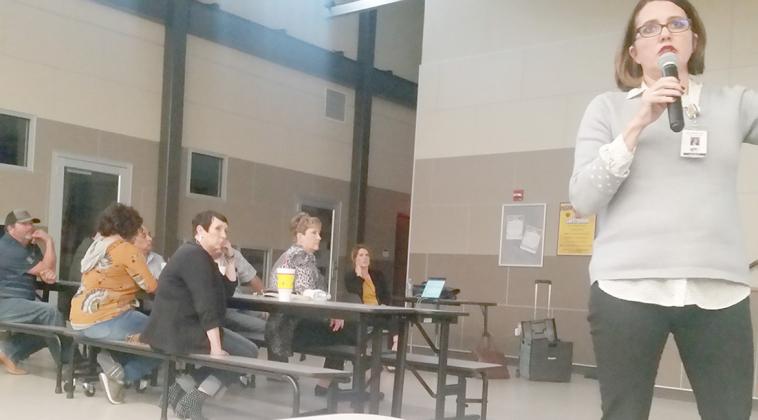While Snyder ISD officials won’t learn what sanctions the Texas Education Agency (TEA) will hit the district with until December, some possible responses are beginning to take shape.
During a public meeting Tuesday, school officials outlined preliminary plans for dealing with the possible sanctions.
The district is facing TEA sanctions because of unacceptable academic performance at Snyder Junior High School the past five years. The sanctions may be either removing the school board and replacing it with a state-appointed board of managers or closing the junior high school and reopening it as a charter school. School district officials are offering another option to the TEA — closing the junior high school and reopening it with the majority of grade levels realigned.
TEA Commissioner Mike Morath will not announce which sanction will be levied until Dec. 13, but school officials are hopeful he will choose the realignment option and they are busy making preliminary plans to respond to that possibility.
Under realignment, district officials envision a variety of changes — some minor, some major — to where students will go to school and how they will be taught.
Under the plan — which officials stressed was very preliminary in nature and subject to significant change — the district would open up an early childhood campus at Stanfield Early Learning Center to house the district’s pre-kindergarten students, while the district’s kindergarten and first graders would attend classes at Snyder Primary School, which would be renamed Snyder Collegiate Primary School.
The district’s high school set-up would remain unchanged, except for the new name Snyder Collegiate High School. But major changes would be made in second through eighth grades.
The preliminary plan calls for students in those grades to follow two pathways of instruction — the collegiate path that would feature more traditional classroom instruction and the academy of inquiry path that include more hands-on, interactive instruction, which is commonly called inquiry-based learning, while also including college and career readiness training.
Second through fifth grade students following the collegiate pathway would attend classes at Snyder Primary School and sixth through eighth grade at the Snyder Intermediate School campus. Students in the academy of inquiry pathway would attend classes at the junior high school campus.
“Pathway one is collegiate focused, but we’re not talking about having 100 percent of our students attend college,” said Assistant Superintendent for Curriculum and Instruction Dr. Rachael McClain. “We want them to graduate with a diploma and other tools to help them be successful in college or a career.”
The collegiate pathway would include a full support program for reading and math, two-way dual language learning and standardized dress, among other features.
“We’re not going to die on our sword over the dress issue, but research has shown that students who dress to certain levels of expectations show positive academic results,” McClain said.
Staffing of the collegiate pathway would include a “graduation coach,” which McClain described as “part educator, part parent” who would be available to students for extra help, team teaching in core classes in sixth through eighth grades and a Dean of Academics to support instruction, along with principals and assistant principals who would fulfill their traditional roles.
The academy of inquiry pathway focus on exploration and hands-on instruction, McClain said. It would feature cross-grade level and cross-curriculum learning opportunities, such as students in third and fourth grade working on a project, or math students sharing a project with science students. As with the other pathways, standardized dress is being proposed.
Staffing would feature all the teachers trained in inquiry-based learning, a director of innovation, who would be focused on directing all academic efforts and principals and assistant principals who would focus on operation and support of staff members.
Selecting which student follows which pathway would be a collaborative effort between teachers, parents and administrators, McClain said. If necessary, a lottery would be used to ensure student demographics remain the same at both campuses.
Audience questions were basically similar to those asked at last week’s public meeting at Snyder High School.
When asked if the charter school option was off the table, Superintendent Dr. Eddie Bland said the district is still reaching out to charter organizations to gauge interest in possibly taking over operations at the junior high school.
Bland also stated, in response to another question, that it would be possible for students to change which pathway they’re assigned.
“Nothing’s locked in,” he said. “We won’t be doing it every six weeks, but we absolutely would allow it.”
One parent asked if students in the different pathways would suffer once they transition to more traditional instruction at the high school. McClain responded by saying that high school students currently follow different academic and career pathways as part of the campus’ P-TECH (Pathways to Technology Early College High School) system.
Regarding special education students, McClain said instruction for those students would be offered in both pathways, although the district’s life skills class might be limited to one or the other.
She also stressed that, regardless of pathway, students’ academic preparation for the State of Texas Assessments of Academic Readiness (STAAR) tests would not be ignored.
“We’re not just going to turn them loose, have them take the STAAR in May and hope for the best. That would be foolish on our part,” she said. “The first six weeks of pathway two are going to look suspiciously like the first six weeks of pathway one. We’re not going to hit the ground running, but will gradually implement inquiry-based learning throughout the school year.”
Public meetings will continue at 6 p.m. today and Thursday in the junior high school cafetorium.


